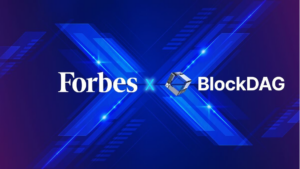Lumerin at Consensus 2023: Distributing mining control to save Bitcoin
FinanceFeeds had the opportunity to speak with Lumerin’s Ryan Condron about its newly launched public testnet for the Hashpower Marketplace, built to enable the distributed control of Bitcoin mining.

Consensus 2023 by CoinDesk, which took place on April 26-28 in Austin, Texas, once again brought together all sides of DeFi, blockchain, Web3, and the metaverse to one of the world’s longest-running crypto, blockchain, and Web3 events.
This year’s conference included world-class speakers from fintech, blockchain, and TradFi, as well as regulatory and lawmaking bodies, such as Circle’s Jeremy Allaire, Custodia Bank’s Caitlin Long, CFTC’s Christy Romero, Yuga Labs CEO Daniel Alegre, Edward Snowden, and even William Shatner.
Lumerin Hashrate Marketplace addresses concentration of mining capacity
Consensus 2023 was announced by CoinDesk as a call to action for developers, investors, founders, policymakers, brands, and others to come together and find solutions to crypto’s thorniest challenges and finally deliver on the technology’s transformative potential. The event came in the wake of the most tumultuous year in crypto history and served as an opportunity to reflect and rebuild.
For example, one of the most pressing issues affecting the blockchain industry, left unaddressed for all these years, is the concentration of mining pools. Foundry USA is the largest bitcoin pool in the world, with 29% of market share. Together with AntPool, they represent (22.4%) over half of the total market, according to data from BTC.com.
This centralizing force in the mining ecosystem may stand as a contradiction and even a threat to the very decentralized purpose of Bitcoin, some would argue. That’s where Lumerin enters the picture with the launch of the public testnet for the Lumerin Hashpower Marketplace.
Buyers can anonymously purchase real Bitcoin hashrate
Lumerin is a Web3 datastream routing protocol with the initial application of providing a completely decentralized application for the buying and selling of Bitcoin mining capacity. Both miners and non-miners will be able to participate in Bitcoin mining via smart contracts on the Ethereum network.
The marketplace is intended to provide miners with additional flexibility and control over their operations for enhanced capacity planning and risk-management strategies. This includes creating contracts to buy hashpower like any other asset, setting the price, speed, and duration of the contract as required.
Ryan Condron, Chief Executive Officer at Lumerin, attended Consensus 2023 and FinanceFeeds Editor-in-Chief Nikolai Isayev had the opportunity to speak with him to learn more about the change the project aims to bring about with the Lumerin Hashpower Marketplace.
“Lumerin is a data routing protocol: a peer-to-peer (P2P) data protocol that gets routing info from smart contracts on ethereum blockchain. We’ve built a decentralized P2P hashrate marketplace so that miners can sell their hashrate in the form of smart contracts on the ethereum ecosystem and buyers can anonymously purchase real bitcoin hashrate and receive it routed directly through the Lumerin node and they can mine with it”, Condron explained.
Bitcoin’s centralized point of failure: 4 pools create +90% of blocks
But why is the quest for distributed control of Bitcoin mining so important? “I think we can point to just about any centralized system at any point in the history of the world and wish we had decentralized it in some way. I don’t care if it’s a religion, a government, or a company, there’s always a point in history where there’s a centralized point of failure, and we realize that if we had better decentralized it, or had more people in control, it might have survived.
“We’re at that point with Bitcoin, where you have essentially four mining pools creating over 90% of the blocks. We see that as a real issue. If you look at the top 2 mining pools, even though they’re nice people they’re still making over 70% of the blocks. That’s a centralized point of failure in an ecosystem”, Condron continued.
“With the Lumerin Hashmarket Marketplace, the idea is to allow anyone to access bitcoin hashrate. Hashrate is bitcoin over time: the longer you control the hashrate, the more you can mine with it, the more you can generate bitcoin. Right now if you want to acquire bitcoin most people in the world have to go through a centralized system – KYC process – in order to receive bitcoin.That’s not freedom. That’s not decentralized sovereignty of an ecosystem. That’s not anonymity. It’s a serious choke point and it goes against why bitcoin was created”
“The Lumerin Marketplace allows the decentralized anonymous purchase of hashrate in a global decentralized marketplace where you can purchase hashrate and create bitcoin yourself”
“You can’t spoof it”
Ryan Condron, who is the CEO of Titan Mining and Principal Blockchain Engineer at Bloq, Inc., also explained what would happen if one of the parties, buyer or seller, doesn’t fulfill their part of the deal in any given contract established in the marketplace.
“It’s all in the code”, he said about the EVM (Ethereum Virtual Machine) smart contracts, which are open source – meaning anyone can read the commitment. “You can actually audit the terms in the code. It’s completely enforced through the blockchain. You can’t spoof it”, Condron continued. “The Lumerin nodes will route from seller to buyer according to the terms. If a seller monkeys with the system or tries to underdeliver the hashrate, the buyer node – which is doing real time validation – will pull the ripcord and will cancel the contract and receive whatever’s left on their side of the contract back.”
Mainnet will be controlled rollout of public testnet
In the initial phase, users will only be able to purchase hashpower through the marketplace and connect to their mining pool, Condron stated. The controlled rollout of the public testnet will give way to complete freedom when we hit the mainnet. “That’s where the craziness starts: anyone can fork the code, launch their own marketplace, create their own rendition of contracts. We don’t govern it. It’s an open source decentralized network.”
While Lumerin doesn’t anticipate specific risks to the network, users are advised to exercise caution in this public beta because their assets are only as safe as their private keys. “We encourage people – that don’t know how to use a web3 wallet, that are not familiar with what is a testnet or mainnet – to educate themselves a bit. When you set up a Lumerin wallet, even though it’s on testnet, it has a private key associated with it. Although it’s fake money (well, there’s still some value to it), I wouldn’t be cavalier about posting on chat forums or giving to someone who says they’re tech support. Treat your private key as private. Don’t broadcast it.
“To test the hashrate, we’re essentially giving away something for free. You’re getting a testnet token, you’re buying a hashrate contract, and your node will receive a real bitcoin hashrate. If you want to send that bitcoin hashrate to a BTC mining pool, then you’ll earn bitcoin. If you want to send the hashrate to the ground, you’ll not get bitcoin, and most likely the nodes will disconnect and nothing will happen. The risks for the end user are pretty nonexistent but we like to remind people they’re dealing with a private key, a mnemonic, and always best practices even if it’s on testnet.”
“We’re 8 billion people. You’re not going to put all of them on one utility chain”
The Lumerin chief executive also commented on the perceived shift from speculation to utility within the crypto ecosystem. “We see this cycle over and over again. It’s every three years essentially: we see a run up in the price, people raise money and get involved, start developing something, and they release it when the market is slow”, he said, pointing to Ethereum and Polkadot as examples of this trend, while noting we’re not yet out of the ‘crypto winter’ and that there’s plenty of overlap in the space, “especially here at Consensus”: “50 different algos, 50 different wallet ecosystems, 100 different ‘Ethereum killers’, but we’re 8 billion people. You’re not gonna put all of them in one utility chain”, he added, concluding there will be multiple blockchains addressing all kinds of needs.

As for regulation…it’s complicated. “For every person that disagrees with regulation, you’ll find someone who agrees and very few regulators are proactive. Most are reactive”, Condron said, as he gave an example close to him: a blockchain project of a friend of his was frozen by regulators so they could investigate and learn about the technology. “You can’t freeze a project in the middle of a technology revolution. That doesn’t make sense”.
The regulation-by-enforcement practice has been quite frustrating for the digital asset ecosystem in the United States and probably ineffective. “We already have laws against fraud. You’ll never be able to protect a person from themselves”.









